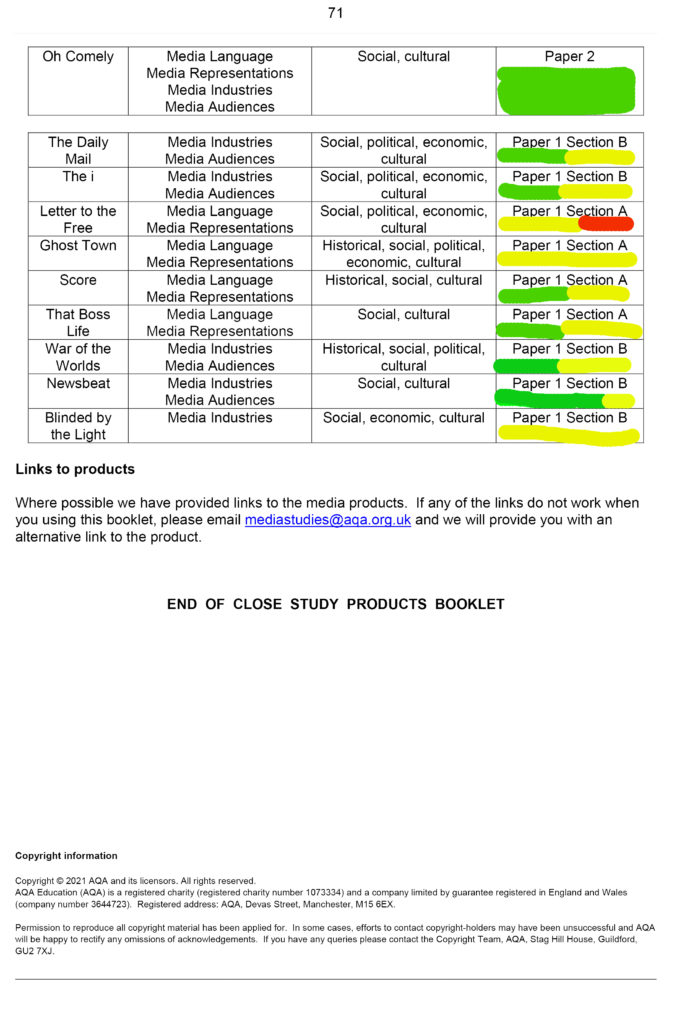| THEME | NEWSBEAT | WOTW |
| OWNERSHIP | BBC, Public Service Broadcasting, Government,
BBC Board of Trustees, DG (Lord Reith), Multimedia, transnational, not a monopoly, concentration of ownership
– owned by the public, everyone is a shareholder. | CBS (Columbia Broadcasting System), Private Company, Multimedia conglomerate, transnational(Yes), monopoly(No),
U.S. COMPANY
example of concentration of ownership i.e. a few companies own everything – oligopoly / cartel (??),
vertical & horizontal integration (??) |
| HABERMAS | Transformation of the public sphere, media is constantly changing – BBC is adapting, BBC intention enshrined in their ethos, profit is not a priority – they put money back into programmes so Quality is important.
Fits notion of transforming the public. Therefore more paternalistic, give you what you need instead of what you want.
| Private business, likely to prioritise making profit. Quality is not as important as long as a profit is made. This profit will not go back into programmes. Does not fit the notion of transforming the public. Less paternalistic, gives you what you want if it makes them money. |
| CHOMSKY | Second filter (advertising) The BBC does not run ads in the UK | Second filter (advertising) CBS runs ads which helps them accrue profit |
| REGULATION | OFCOM, BBC Charter governed by parliament, license fee regulates BBC, BBC Ethos – educate, inform and entertain (Reith)
BBC has a left wing, libertarian ideology (??) | Federal Communications Commission regulates private businesses i.e. not necessarily in public interest |
| AUDIENCE (ACTIVE/PASSIVE) | Audiences are more active, they are not just given programmes that they want but are given what they need (Paternalism) | Audiences are more passive, they are only shown the programmes that they want to allow in order for CBS to make a profit. |
| AUDIENCE (LAZARSFELD) | The two-step flow of communication model hypothesizes that ideas flow from mass media to opinion leaders, and from them, to a wider population. It was first introduced by sociologist Paul Lazarsfeld in 1944
This relates to the specific textual example of Prince William and Kate presenting a special newsbeat edition on mental health
The mass media flow ideas into the PSB BBC, flowing their ideas through various outlets as they are a multimedia convergence. They help promote their message through various opinion leaders such as Stormzy, Prince William and Kate presenting a special newsbeat edition on mental health | Can use opinion leaders to make message more relevant |
| SPECIFIC TEXTUAL EXAMLES | Prince William and Kate presenting a special newsbeat edition on mental health
Kanye article.
^ This proves that the BBC care more about the viewers and want to supply a service that is educational, informal and entertaining | blurred codes of drama and news. Programme starts with title music, announcer introduction ‘Mercury Theatre Company presents . . . ‘ followed by Orson Welles prologue to War of the Worlds .. .
|
| AUDIENCE (HALL) | Reception Theory – | |
| GERBNER | The Cultivation Theory suggests heavy television exposure will have a significant influence on our perception of the real world. The more we see a version of reality being depicted on the screen, the more we will believe it is an accurate reflection of society. | Cultivation theory links as the newly heavy influence of new media productions, through the introduction of radio, shows an example of this theory as it could have affected the public in a large way as a lack of knowledge and an imbedded naiveness that may of allowed the public to be victim to this hysteria produced by War of the worlds.
|
| NEW TECHNOLOGY | New Technologies mean that the BBC is faced with more competition.
Newsbeat is on social media, internet radio and apps. | Radio |
| CROSS MEDIA CONVERGENCE | | |
| CURRAN | – “depended on a set of linked and radical expansions”
– “the BBC creating an image of its audience as ‘participants’ in the great affairs of the nation…”
– Since the BBC is a PSB it uses the money it makes to improve itself and further benefit the public with a massive majority of different opinions straying away from lack of creativity that large conglomerates supply in which only function as a motive to generate a profit, which differs from the BBC. | – Private Company, Multimedia conglomerate. This means that CBS only operates as a function to generate a profit and please the shareholders, in which can lack creativity and care for the public. It will generate any kind of story in hopes to generate a profit, meaning they can lack integrity. |
| SEATON | Seaton makes us aware of the power of the media in terms of big companies who own too much.
– Commercial broadcasters selling audiences to products NOT audiences to programs like the BBC. (ie no adverts on BBC).
Meaning that the BBC are not chasing big exaggerated stories and appeals to informed citizens who want knowledge. | Seaton talks about rise and inevitable need for competition with new technologies.
– Providing choice and more entertainment for wider audiences perhaps.
the allusion of Choice – “Choice, without positive direction is a myth, all too often the market will deliver more -but only more of the same”
CBS, as well as other businesses, create different media products as a sole motive to generate a profit. Meaning that when they produce programs, they will only generate products that they know will perform well, creating this idea on the illusion of choice, whereas in reality it is a well thought out process which involves repeated actions and choices in which have been largely successful in practice. |
|




